Why Yotam Ottolenghi loves Australian food (plus three new recipes you’ll love)
In this exclusive extract from new cookbook, Comfort, Yotam Ottolenghi and team write in praise of the land down under — and share recipes to put on high rotation.
What makes food “comfort” food? For us, it’s about travel, about movement and migration. Comfort, on this basis, is for everyone. Particularly so, though, for Australia: a quarter of the population – one in four people! – were born overseas.
It is a country that, perhaps more than any other, has taken to its heart (and stomach) the food traditions of so many cultures, from so many places, from so many people moving and migrating.
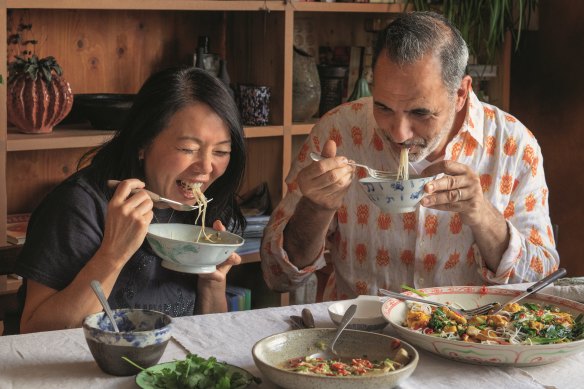
It was around the time Australian-trained pastry chef Helen Goh arrived in the UK and joined the large Ottolenghi family that Yotam’s love affair with Australia began.
Through Helen, but also independently, over many visits and book tours, there was a quick realisation of all the things he had in common with this nation:
- The love of different ingredients and big flavours
- The insatiable appetite to explore new cuisines
- The obsession with baking
- The deep understanding that good food knows no boundaries
- The heartfelt gesture of hospitality that only food can provide
- The joy of feeding and of being fed
Related Article
Related Article
Helen’s story is, in its way, quintessentially Australian. Born in Malaysia, she arrived when she was 11 with her three sisters, brother and parents, who, like so many before them and since, brought their family to this land in search of a place of opportunity and safety.
The spatchcock chicken, for example, arrived with Auntie Pauline (who wasn’t actually an auntie) from Malaysia and was served at weekend cricket games.
The rice vermicelli with turmeric fish is a riff on Cha ca La Vong, a staple of Vietnamese cuisine, now an integral part of Australia’s food landscape.
Our own “shakshuka”, with its tamarind, ginger and chilli heat, is loosely based on Helen’s memories of Malaysian nasi lemak, and echoes the baked eggs Yotam grew up with in Jerusalem.
You can see how wonderfully circular and symbiotic this process is for us: of memory, comfort and innovation. This kind of unique comfort, of a big, warm embrace, is what we love so much about Australia, and so much of it has to do with this dynamic movement of people and their foods.
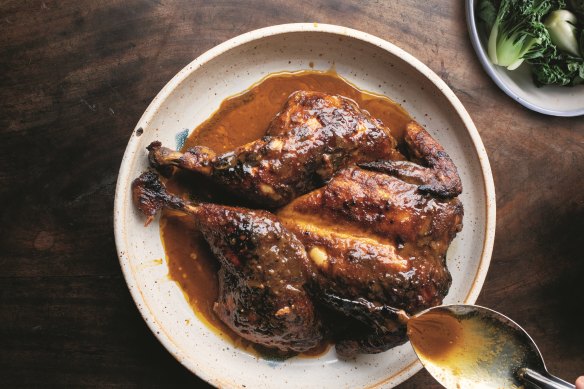
Roast chicken with Auntie Pauline’s marinade
As with all the best aunties, Auntie Pauline wasn’t really an auntie. She was a friend of Helen’s family who migrated to Australia from Malaysia at the same time as them. They would meet in the park, play cricket and barbecue meat on the public grills. What was being grilled varied – chicken wings or thighs were a favourite, prawns also – but the marinade was too good to change. Make more of the marinade than you need, if you like: it freezes well for future use. Serve this with a big green salad or some pak choi.
Ingredients
- 1 whole chicken (1.5kg-1.7kg), spatchcocked (ask your butcher to do this for you or look online for a tutorial)
Marinade
- 5 garlic cloves, roughly chopped
- 15g ginger, peeled and roughly chopped
- 50ml light soy sauce
- 6-7 limes, juiced, to get 110ml
- 55g palm sugar, roughly chopped (or light soft brown sugar)
- 75ml peanut (or sunflower) oil
- 1¾ tsp hot chilli powder
- 4 tsp ground coriander
- 30g coriander: stems roughly chopped (20g), leaves roughly chopped to serve (10g)
- 150ml coconut milk
- 25ml fish sauce
- salt
Method
- Place all the ingredients for the marinade in a blender or food processor, along with ¾ teaspoon of salt. Blend well, until completely smooth. Place the chicken in a large container for which you have a lid, pour over the marinade and leave in the fridge overnight. Turn the chicken once or twice as it marinates so that all sides get coated.
- Preheat the oven to 185C fan-forced (205C conventional).
- Place the chicken, along with half the marinade, in a baking dish or tray roughly 24cm x 32cm. Roast for 30 minutes, basting once or twice. After 30 minutes, spoon over the remaining marinade and continue to cook for 25-30 minutes. Turn off the oven but leave the chicken inside to rest for 15 minutes, with the oven door slightly open.
- Transfer the chicken to a serving dish and pour the roasting sauce into a serving jug. Sprinkle the coriander leaves over the chicken and serve with the sauce alongside.
Serves 4
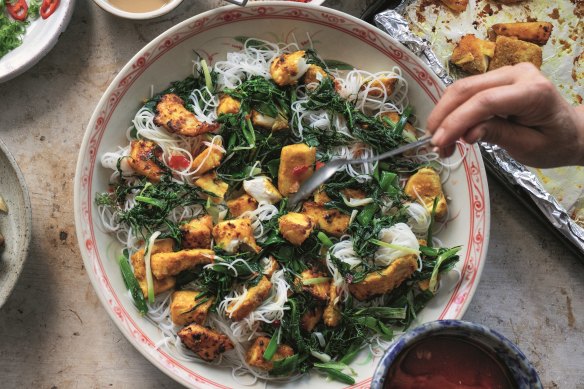
Rice vermicelli with turmeric fish, dill and spring onion
This is one of those back-pocket recipes which, if you’ve made the marinade and dipping sauce in advance, feels pretty much like fast food when it comes to cooking. The noodles are near-instant, and the spring onions and dill take as little time to chop and wilt as the fish takes to grill. A total treat on the table in 5 minutes.
Getting ahead: The paste for the marinade can be made up to 3 days ahead and kept refrigerated. Don’t mix it with the fish more than an hour before grilling, though: if you do, the fish will start to break down.
Ingredients
- 600g firm white fish fillets, sliced into 5cm strips
- 2 tbsp peanut (or sunflower) oil
- 200g dried rice vermicelli noodles
- 12-14 (125g) spring onions, green and white parts cut into 5cm lengths (slice the white stems lengthwise if they are very thick)
- 50g dill sprigs, tough stalks removed but kept as sprigs
- 2 bird’s-eye chillies, thinly sliced
- 40g roasted salted peanuts, roughly chopped
- salt
Marinade
- 1 banana shallot, roughly chopped (45g)
- 20g ginger, peeled and roughly chopped
- 2 garlic cloves, roughly chopped
- 1 tbsp fish sauce
- 1 tbsp peanut (or sunflower) oil
- 1 tsp ground turmeric
- 1 tsp medium or hot curry powder
Nuoc cham
- 2 garlic cloves, roughly chopped
- 1 small red bird’s-eye chilli, roughly sliced
- 1 large mild red chilli, roughly sliced
- ¼ tsp flaked sea salt
- 2 tbsp roughly chopped palm sugar (or caster sugar)
- 2 tbsp lime juice
- 60ml fish sauce
- 60ml rice wine vinegar
Method
- Put all the ingredients for the marinade into the small bowl of a food processor. Blend to form a smooth paste, then transfer to a medium bowl. Add the fish, toss gently to coat, then keep in the fridge, covered, for about (but not much longer than) 30 minutes.
- Meanwhile, make the nuoc cham. Put the garlic, chillies and flaked salt into a pestle and mortar and pound to form a wet paste: the chillies won’t break down completely. Add the remaining ingredients, then transfer to a screw-top jar. Shake vigorously, and keep in the fridge until ready to serve. If you don’t have a pestle and mortar, place all the ingredients in a food processor and pulse until the chillies and garlic are broken up.
- When ready to serve, preheat the oven grill to its highest setting and position a rack in the upper third of the oven. Cover a large baking tray with foil and brush lightly with 1 tablespoon of the oil. Spread the fish out on the tray and grill for about 8 minutes, carefully turning it over halfway through so that both sides are golden brown. Switch off the grill and place the tray on the lowest rack of the oven to keep the fish warm. Leave the oven door ajar.
- While the fish is cooking, put the noodles into a large bowl and cover with just-boiled water. When softened (3-5 minutes, depending on the brand), drain in a colander and set aside.
- Put the remaining tablespoon of oil into a large frying pan (or wok) and place over medium-high heat. When hot, add the spring onions and ⅛ teaspoon of salt. Stir-fry for 1 minute, then add the dill sprigs and toss and fry for another 30 seconds or so, until they just wilt and turn bright green. Remove the pan from the heat, leaving the greens in the pan.
- When ready to serve, divide the rice noodles between four bowls. Top with the fish, followed by the spring onions and dill. Pour 2-3 tablespoons of the nuoc cham over the top, then scatter over some sliced chillies and chopped peanuts. Serve warm or at room temperature, with the remaining nuoc cham in a bowl for everyone to help themselves.
Serves 4
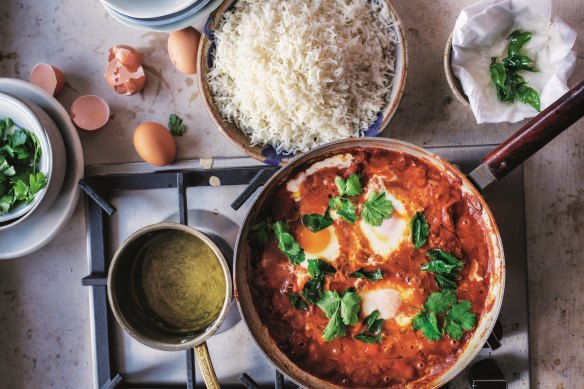
Egg sambal ‘shakshuka’
Growing up in Malaysia, nasi lemak was something Helen ate a lot of. Wrapped in banana leaves and day-old newspaper, the little packs of coconut rice, spicy sambal, egg and cucumber are sold on nearly every street corner. While this recipe is very much not nasi lemak, it is nevertheless inspired by it. The egg and tomato sauce mingling in the pan reminds us, at the same time, of the shakshuka that Yotam grew up eating in Jerusalem. Serve with rice, flatbread or any bread you like.
Getting ahead: This can be made in advance, up to the point just before the eggs are cracked into the sambal. The sambal lasts well in the fridge for up to 3 days.
Ingredients
- 1½ tsp fennel seeds
- 2 whole cloves
- seeds from 2 cardamom pods
- ½ tsp ground cinnamon
- 1½ tbsp medium curry powder
- 60ml olive oil
- ½ tsp black mustard seeds
- 20 curry leaves
- 1 red onion, halved and thinly sliced (160g)
- 10g ginger, peeled and finely grated
- 5 garlic cloves, crushed
- 10g coriander, stalks finely chopped and leaves to serve
- 150g cherry tomatoes
- 2 tsp sambal oelek
- 1 x 400g can crushed tomatoes
- 100ml tamarind concentrate
- 300ml water
- 15g palm (or light soft brown) sugar
- 5 eggs
- salt and black pepper
Method
- Put the fennel seeds, cloves and cardamom seeds into a small dry frying pan and place on medium-low heat. Toast lightly for about 2 minutes, until fragrant, then grind to a powder in a spice grinder or a pestle and mortar. Add the cinnamon and curry powder and set aside.
- Put 3 tablespoons of the oil into a large saute pan (for which you have a lid) – about 26cm wide – and place on medium heat. Add the mustard seeds and 10 curry leaves and cook for 1 minute, until the seeds begin to pop. Add the onion and cook for about 7 minutes, stirring frequently, until it is starting to colour. Add the ginger, garlic, coriander stalks and fresh tomatoes, cook for another 5 minutes, then add the fennel spice mix. Cook for 2 minutes, until fragrant, then add the sambal oelek, tinned tomatoes, tamarind, water, sugar and 1¼ teaspoons of salt. Stir well and bring to a simmer. Reduce the heat to medium-low and cook for 20-25 minutes, uncovered, until thickened.
- Crack the eggs into the sambal and sprinkle a little salt and pepper over each egg. Cover the pan and cook for 7-8 minutes, until the egg whites are fully cooked and the yolks are soft.
- Meanwhile, put the remaining tablespoon of oil into a small pan and place on medium heat. Add the rest of the curry leaves, cook for about a minute, until very fragrant, then remove from the heat. When the eggs are ready, drizzle the oil and fried curry leaves over the eggs, scatter over the coriander leaves, and serve.
Serves 4

This is an edited extract from Ottolenghi Comfort by Yotam Ottolenghi, Helen Goh, Verena Lochmuller and Tara Wigley (Ebury Press, $65). All photography by Jonathan Lovekin. Out September 3.
Related Article
Related Article
Related Article
Continue this series
Here are recipes from 30+ of the best cookbooks of 2024Up next
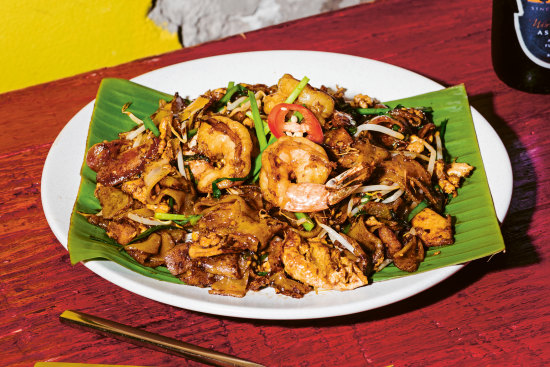
How to make Ho Jiak’s signature char kway teow (plus three other cult noodle dishes)
The Sydney restaurant’s popular rice noodle dish is spicy, smoky and much darker than the usual CKT. Founder Junda Khoo shares his secrets.
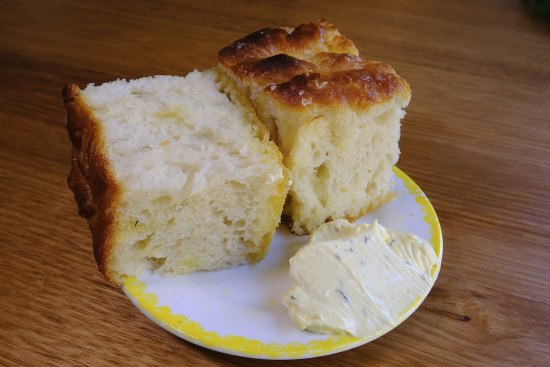
How to make one of Melbourne’s favourite focaccias at home
The former head chef of Hope St Radio, Ellie Bouhadana, shares her famed focaccia and butter recipes.
Previous
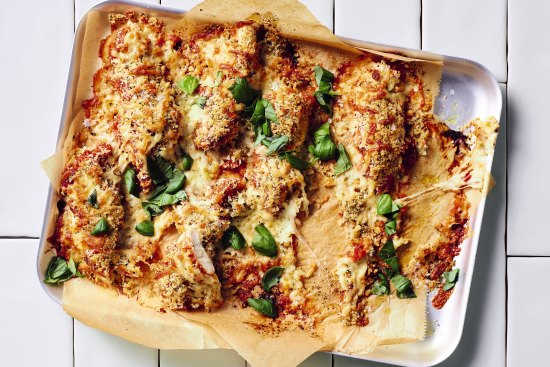
These cheesy one-tray chicken tenders from Sarah Pound will feed the whole fam
Plus three other quick dishes by our new columnist and recipe writer, including a shortcut to easy meatballs.
The best recipes from Australia's leading chefs straight to your inbox.
Sign up



